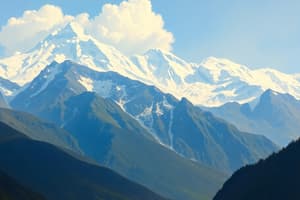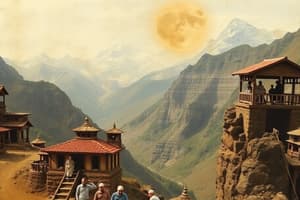Podcast
Questions and Answers
Which of the following peaks is not located in the Central Himalaya region of Uttarakhand?
Which of the following peaks is not located in the Central Himalaya region of Uttarakhand?
- Nanda Devi
- Kamet
- Trishul
- Kedarnath (correct)
Which of the following is not a common vegetation type found in Uttarakhand?
Which of the following is not a common vegetation type found in Uttarakhand?
- Alpine meadows
- Tropical rainforests (correct)
- Temperate forests
- Coniferous forests
What type of climate characterizes the Himalayan region of Uttarakhand?
What type of climate characterizes the Himalayan region of Uttarakhand?
- Temperate climate with warm summers
- Desert climate with minimal precipitation
- Tropical climate with heavy rainfall
- Alpine climate with cold winters and mild summers (correct)
What is the primary economic activity in the Uttarakhand region?
What is the primary economic activity in the Uttarakhand region?
Which of the following animals is an important wildlife species found in Uttarakhand?
Which of the following animals is an important wildlife species found in Uttarakhand?
Which of these factors poses a significant threat to conservation efforts in Uttarakhand?
Which of these factors poses a significant threat to conservation efforts in Uttarakhand?
Which region is known for its popular trekking routes like Roopkund and Gomukh?
Which region is known for its popular trekking routes like Roopkund and Gomukh?
Which ethnic group is prominently found in the Uttarakhand region?
Which ethnic group is prominently found in the Uttarakhand region?
Flashcards
Central Himalaya
Central Himalaya
A section of the Himalayas that includes parts of Uttarakhand, known for its high peaks and valleys.
Topography of the Central Himalayas
Topography of the Central Himalayas
The diverse landscape of the Central Himalayas, encompassing towering mountains, valleys, glaciers, and ridges.
Alpine climate
Alpine climate
The climate typical of the Central Himalayas, characterized by cold winters, mild summers, and significant snowfall in winter.
Biodiversity of the Central Himalayas
Biodiversity of the Central Himalayas
Signup and view all the flashcards
Agriculture in the Central Himalayas
Agriculture in the Central Himalayas
Signup and view all the flashcards
Tourism in the Central Himalayas
Tourism in the Central Himalayas
Signup and view all the flashcards
Protected areas in the Central Himalayas
Protected areas in the Central Himalayas
Signup and view all the flashcards
Conservation challenges in the Central Himalayas
Conservation challenges in the Central Himalayas
Signup and view all the flashcards
Study Notes
Geography and Location
- The Himalayas in Uttarakhand are part of the greater Himalayan range.
- Central Himalaya refers to the section of the Himalayas that includes parts of Uttarakhand.
- Major peaks: Nanda Devi, Kamet, and Trishul.
- The region features diverse topography, including valleys, glaciers, and ridges.
Climate
- Alpine climate with cold winters and mild summers.
- Significant snowfall in winter; monsoon rains from June to September.
- Temperature varies greatly with altitude.
Biodiversity
- Home to rich flora and fauna, including endemic species.
- Vegetation types: alpine meadows, coniferous forests, and temperate forests.
- Important wildlife: snow leopard, musk deer, Himalayan tahr, and various bird species.
Culture and People
- Inhabited by various ethnic groups, including the Garhwalis and Kumaonis.
- Rich cultural heritage with traditions, festivals, and local crafts.
- The region is known for its pilgrimage sites like Badrinath and Kedarnath.
Economy
- Agriculture is the mainstay, with crops like maize, barley, and potatoes.
- Tourism plays a significant role, driven by trekking, mountaineering, and spiritual journeys.
- Handicrafts and local products contribute to the economy.
Conservation
- Protected areas include Nanda Devi Biosphere Reserve and Valley of Flowers National Park.
- Conservation efforts are underway to protect biodiversity and manage tourism impacts.
- Challenges include climate change, deforestation, and human-wildlife conflict.
Adventure Activities
- Popular trekking routes: Roopkund, Kedartal, and Gomukh.
- Mountaineering opportunities on various peaks, attracting climbers globally.
- River rafting and camping are also common in the region.
Geography and Location
- The Himalayas in Uttarakhand are a segment of the greater Himalayan range, characterized by rugged terrains.
- Central Himalaya encompasses parts of Uttarakhand, notable for its high peaks and valleys.
- Major peaks in this region include Nanda Devi, Kamet, and Trishul, which are significant for both their height and cultural importance.
- The diverse topography features not only towering mountains but also valleys, glaciers, and ridges, contributing to a distinct landscape.
Climate
- The region experiences an alpine climate, marked by cold winters and mild summers, influencing local flora and fauna.
- Winter brings significant snowfall, while the monsoon season from June to September provides most of the annual rainfall.
- Temperature fluctuations are considerable, varying greatly with altitude, leading to different climatic conditions across the region.
Biodiversity
- The area hosts a rich diversity of flora and fauna, with many species endemic to the region.
- Vegetation types vary from alpine meadows at higher elevations to coniferous and temperate forests lower down.
- Key wildlife includes the snow leopard, musk deer, Himalayan tahr, and a variety of bird species, highlighting the ecological significance of the region.
Culture and People
- The population includes various ethnic groups, principally the Garhwalis and Kumaonis, each with unique cultural practices.
- The region boasts a rich cultural heritage encompassing traditional festivals, local crafts, and unique customs.
- Pilgrimage sites such as Badrinath and Kedarnath attract visitors and are integral to the religious fabric of the area.
Economy
- Agriculture serves as the economic backbone, with staple crops like maize, barley, and potatoes being cultivated.
- Tourism significantly boosts the local economy, with activities such as trekking, mountaineering, and spiritual journeys driving visitor interest.
- Handicrafts and other local products further contribute to economic development, showcasing the skills of local artisans.
Conservation
- Protected areas like Nanda Devi Biosphere Reserve and Valley of Flowers National Park are vital for conserving biodiversity.
- Ongoing conservation efforts aim to mitigate the impact of tourism and preserve the ecological balance in the region.
- Challenges such as climate change, deforestation, and human-wildlife conflict threaten both natural habitats and local livelihoods.
Adventure Activities
- Popular trekking routes include Roopkund, Kedartal, and Gomukh, attracting adventurers seeking natural beauty and challenge.
- Mountaineering opportunities on various peaks draw climbers from around the world, enriching the adventure tourism sector.
- Additional activities like river rafting and camping enhance the outdoor experience available in this stunning region.
Studying That Suits You
Use AI to generate personalized quizzes and flashcards to suit your learning preferences.
Description
This quiz covers the geography and climate of the Himalayas, focusing on the region of Uttarakhand. Explore major peaks like Nanda Devi and Kamet, as well as the diverse topography and weather patterns that define this unique ecosystem.




